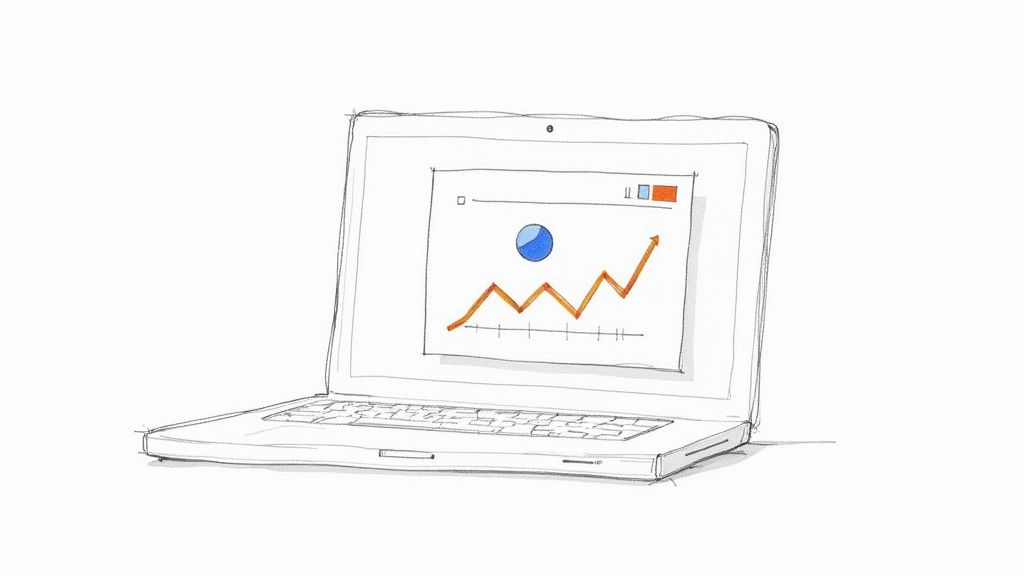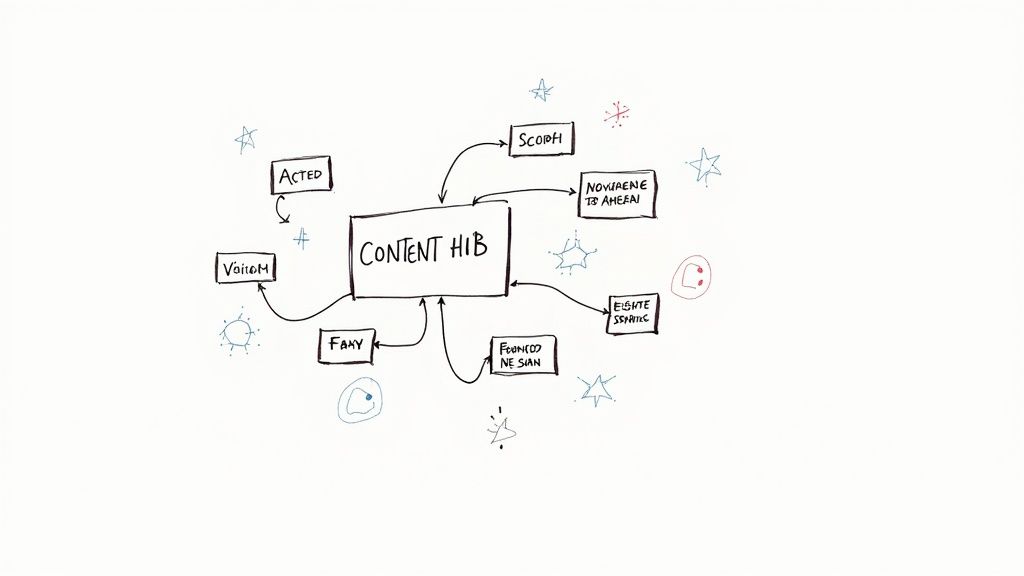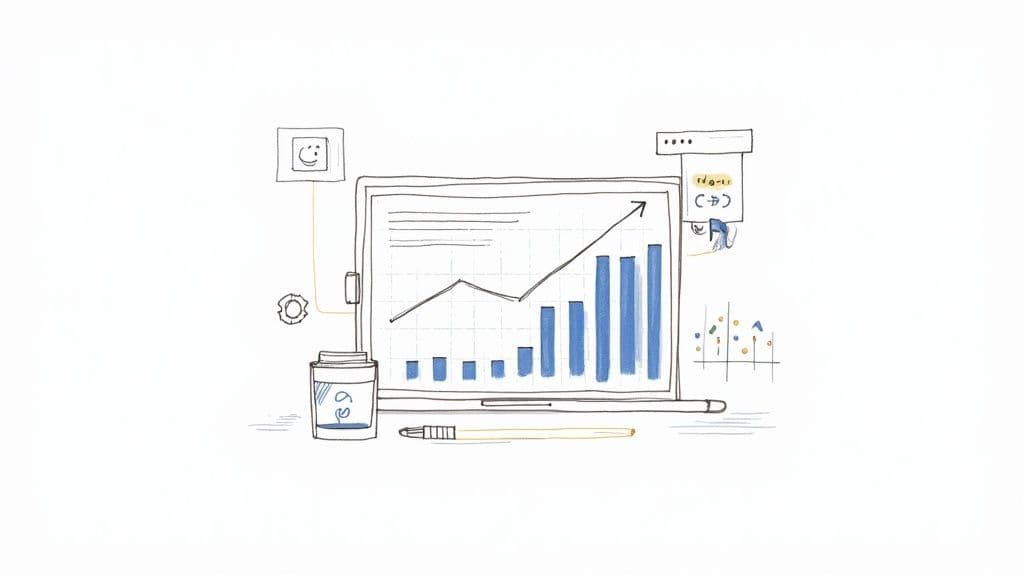Decoding Bounce Rate: What It Reveals About Your Website
A high bounce rate can be disheartening. However, understanding its meaning is vital for website optimization. This metric provides insights into user behavior, content effectiveness, and overall website performance. Knowing this empowers you to improve user engagement.
Understanding this metric helps you make informed optimization decisions. It's not just about the numbers, but what those numbers represent about your visitors' interaction with your site. This knowledge can help you create a more user-friendly and engaging experience.

Understanding the Nuances of Bounce Rate
A bounce happens when a visitor lands on your website and leaves without further interaction. They don't click other pages, submit forms, or engage with interactive elements. The bounce rate is the percentage of visitors who bounce.
A high bounce rate isn't always bad. A blog post might have a higher rate because users read the article and leave. This is considered normal behavior for this type of content. It doesn't necessarily indicate a problem with the site itself.
However, a high bounce rate on product or landing pages can be a red flag. This might signal issues with page load speed, confusing navigation, or irrelevant content. For instance, slow loading times can cause visitors to leave before the content even loads.
Benchmarking Your Bounce Rate Against Industry Averages
Context is key when setting optimization goals. Understanding industry averages is critical for addressing how to reduce website bounce rate. A comprehensive analysis shows the average bounce rate across industries is around 55.43%.
This means over half of visitors leave after viewing a single page. This benchmark helps evaluate your website's performance. Use it as a starting point to see how your site stacks up against others in your industry. More detailed information can be found here: Business Dasher - Bounce Rate Benchmarks
To help you better understand industry benchmarks, we've compiled the following table:
Average Bounce Rate Benchmarks Comparative data showing average bounce rates across different industries to help readers benchmark their own performance.
| Industry | Average Bounce Rate (%) | What's Considered Good (%) | What's Considered High (%) |
|---|---|---|---|
| E-commerce | 20-45 | <20 | >45 |
| B2B | 25-55 | <25 | >55 |
| Content/Blogs | 65-90 | <65 | >90 |
| Landing Pages | 60-90 | <60 | >90 |
This table highlights how different industries experience varying bounce rates. For example, e-commerce sites generally aim for a lower bounce rate compared to content-heavy sites.
Identifying the Underlying Causes of a High Bounce Rate
A high bounce rate often reveals underlying website issues. These can be technical, like slow loading speed. They can also be design-related, such as poor user experience (UX) or confusing navigation.
Content relevance matters too. If your content doesn't meet user intent, visitors are more likely to leave. This underscores the connection between website elements and user behavior. Addressing these root issues is the key to lasting improvement.
Speed Optimization: The First Impression That Matters

Page speed is critical to whether a visitor stays or bounces. Those first few seconds can make or break the user experience. Even seemingly minor delays can significantly impact your bounce rate. Today’s users expect speed and have little patience for slow websites.
For example, studies show that a one-second delay in page load time can lead to an 11% decrease in page views and a 7% reduction in conversions. This underscores the importance of speed optimization for keeping visitors engaged. High-performing websites understand this and prioritize speed for user satisfaction and increased revenue.
Practical Techniques for Speed Optimization
You can dramatically improve your website's speed with several techniques. These include image optimization, code streamlining, and browser caching. For instance, modern image formats like WebP can significantly reduce file sizes without compromising quality.
Minifying your website's CSS and JavaScript files also improves load times. For more detailed information, you might find this helpful: How to master website speed improvements.
By implementing these techniques, you can create a faster, more efficient website, resulting in a lower bounce rate. Prioritizing above-the-fold content is another key strategy. This loads the visible content first, giving visitors something to see immediately while the rest of the page loads.
Identifying and Addressing Performance Bottlenecks
While general speed optimization advice is beneficial, identifying your website's specific bottlenecks is essential. Analyze your performance with tools like Google PageSpeed Insights.
These tools pinpoint specific areas for improvement, offering tailored recommendations instead of generic solutions. Understanding the psychology of speed is also important. Users associate faster websites with trustworthiness and professionalism, influencing their decision to explore your site further.
Steps to a Faster Website
Here’s a concise action plan:
- Optimize Images: Compress images using tools like TinyPNG or ShortPixel. Use next-gen formats like WebP.
- Minify Code: Remove unnecessary characters from your HTML, CSS, and JavaScript files.
- Leverage Browser Caching: Configure your server to allow browsers to store static assets, reducing redundant downloads.
- Use a CDN: A Content Delivery Network distributes your content across multiple servers, reducing latency for global users.
- Choose a Fast Hosting Provider: Your hosting provider significantly impacts website speed. Choose a reputable provider with a proven performance record.
By following these strategies, you can build a fast-loading website that keeps visitors engaged, reduces your bounce rate, and improves your overall website performance.
Above-the-Fold Mastery: Capturing Attention Instantly

The above-the-fold section, the area visible without scrolling, is essential for grabbing a visitor's attention and minimizing bounce rate. Think of it as your website's first impression, like a storefront window enticing customers to enter. A compelling above-the-fold experience encourages deeper exploration, directly contributing to your website's success.
This initial view heavily influences a visitor's decision to stay or leave. If the content isn't immediately engaging, they might leave before even seeing what's below the fold. Optimizing this crucial space is paramount to capturing attention and promoting further interaction.
Crafting Headlines That Speak to Visitor Intent
Your headline is the first element visitors notice. It must be clear, concise, and directly address their search intent, acting like a hook that promises value and relevance. Instead of a generic headline like "Services," opt for something specific like "Boost Your Website Traffic with Our SEO Services."
Visual prominence is also key. Use a large, readable font and contrasting colors to ensure your headline immediately grabs attention and clearly communicates the page's purpose.
Communicating Value Propositions Instantly
Beyond the headline, your above-the-fold content needs to clearly convey your value proposition. What problems do you solve, and why should visitors stay on your page? This information needs to be readily apparent. Highlight key benefits using bullet points and concise descriptions.
Strong visuals, such as images or videos, can quickly convey information and enhance your message. They create a positive first impression and make your value proposition more engaging and memorable, ensuring visitors immediately grasp your offering.
The Psychology of Visual Hierarchy and Attention Flow
Understanding how visitors visually scan a webpage is critical for above-the-fold optimization. Eye-tracking studies reveal users often follow an "F-shaped" pattern, focusing first on the top-left corner. Design your content with this in mind, strategically placing the most crucial information.
Use directional cues, such as arrows or visual pathways, to guide visitors' eyes toward key elements. This establishes a natural flow that encourages exploration and reduces bounce rate. Strategic use of white space and contrast further enhances readability and overall visual appeal.
Analyzing different website types reveals variations in bounce rates, informing tailored optimization strategies. Blogs often have higher bounce rates (70-90%) as users frequently leave after reading a single post. Service sites tend to have lower rates (10-30%) as visitors explore multiple pages. Even platforms like Twitter experience bounce rate challenges (around 71.46% in July 2023). More detailed statistics can be found here: My Codeless Website - Bounce Rate Statistics
Implementing a Testing Framework for Continuous Improvement
Don't rely on guesswork. Utilize A/B testing to determine which elements resonate best with your audience. Test variations of headlines, images, and calls to action to identify what drives the highest engagement and reduces your bounce rate. This data-driven approach ensures continuous improvement and optimization.
Analyzing user behavior through tools like heatmaps and session recordings provides invaluable insights into how visitors interact with your above-the-fold content. Use this data to identify areas for improvement and refine your design for maximum impact. This ensures your above-the-fold design consistently captures attention and encourages visitors to explore your website further.
Strategic Navigation: Guiding Visitors Deeper Into Your Site

Intuitive navigation is key to a positive user experience. It also directly impacts your bounce rate. A well-structured website seamlessly guides visitors through your content. This encourages them to explore multiple pages and ultimately reduces bounce rate. It involves thinking beyond basic menus and considering the user's journey. Think about their experience from initial landing to desired actions.
This section explores building navigation that helps users find what they need quickly and efficiently. Just like a well-organized library, clear site navigation is crucial. It helps users discover relevant content without frustration. This seamless experience encourages users to explore more of your website.
Contextual Internal Linking: Creating Natural Pathways
Internal linking creates a web of connections within your site. These links must be relevant and contextual to be effective. Strategically place them within your content where they naturally fit. Avoid simply scattering links randomly throughout your site. Place them where they complement the information and encourage further exploration.
For example, if you’re discussing SEO tools on one page, link to a related blog post about website performance optimization. This provides valuable resources for the reader and keeps them engaged. This practice transforms internal links. They become valuable additions to the user's experience, not just navigational tools. Learn more in our article about How to master website navigation.
Content Clusters: Building Natural Exploration Paths
Content clusters group related content around a central topic. This approach creates a natural exploration path. It leads visitors from general overviews to more specific information. This logical flow keeps users engaged and reduces dead ends within your site.
Think of this strategy as creating themed sections within your website. Each cluster becomes a hub of interconnected information. This creates a more comprehensive and user-friendly resource. It encourages deeper exploration and reduces the likelihood of visitors leaving after just one page.
Choice Architecture: Preventing the Paradox of Choice
Presenting too many options can overwhelm visitors. This can lead to decision paralysis and increased bounce rates. This is the paradox of choice. Streamlining menus helps guide users towards the most relevant choices. Effectively categorizing content and prioritizing key information also guides users.
A website with a focused selection of clear options reduces user overwhelm. This clear guidance encourages more meaningful engagement. It also reduces the impulse to abandon the site.
Industry-specific benchmarks inform how tailored strategies affect bounce rate. For example, in 2023, healthcare websites had an average bounce rate around 58.29%. The food and beverage industry experienced bounce rates ranging from 56.62% to 65.52%. Compared to the average of 55%, these sectors require particular attention to content clarity and mobile responsiveness. Discover more insights about industry bounce rates here.
Mobile Navigation: Optimizing for Thumb-Driven Browsing
Mobile users interact with websites differently. Consider thumb-friendly design. Prioritize ease of navigation on smaller screens. Ensure menus are easily accessible and buttons are appropriately sized. Format content for one-handed browsing.
These mobile-specific considerations improve user experience and reduce bounce rates on smaller devices. Recognizing these differences in browsing behavior is critical. It is key to a successful mobile strategy and a key step in reducing website bounce rate.
Content That Connects: Beyond Basic Engagement Tactics
Creating compelling content involves more than just presenting information. It's about crafting an engaging experience that encourages visitors to explore your website further. This directly tackles the issue of reducing bounce rate by aligning content with visitor intent and providing a satisfying online experience.
Understanding Visitor Intent: Beyond Keywords
Effective content starts with understanding your audience. High-performing content teams go beyond basic keyword research. They investigate the underlying motivations and needs that drive visitor behavior. For example, someone searching for "best laptop for graphic design" isn't simply looking for technical specifications. They are looking for a tool that will support their creative work and improve their workflow.
This means content needs to address both the practical aspects of a search query and the emotional motivations behind it. By understanding these deeper motivations, you can create content that genuinely resonates with your target audience and encourages them to explore your website.
Creating Scannable Content: Respecting How People Read Online
Online reading habits are different from traditional reading. Visitors often scan web pages quickly, searching for key information. This means that even long-form content needs to be easy to digest. Use techniques like headings, subheadings, bullet points, and short paragraphs to create scannable content.
Incorporate visuals like images and videos to break up text and keep readers engaged. This allows visitors to quickly grasp the value of your content and encourages them to stay longer, thus reducing bounce rate.
The Power of Multimedia: Enhancing Engagement Without Sacrificing Speed
Multimedia elements can significantly enhance time spent on a page. However, it's essential to use them strategically without impacting website loading speed. For example, embed videos from platforms like YouTube rather than hosting large video files directly on your server.
Optimize images for web use with appropriate file formats and compression to ensure quick loading times without compromising quality. Balancing engaging multimedia with optimal website performance creates a smooth and captivating experience for your visitors.
Personalization: Tailoring the Experience
Personalization can significantly improve user engagement. You can achieve this without complex implementation by segmenting your audience and providing tailored content. For example, you can show different calls to action based on a visitor’s previous activity on your site.
Additionally, use data like location or browsing history to customize content and offers. This personalized approach makes visitors feel valued and understood, which leads to increased engagement and a lower bounce rate.
To help understand how these strategies apply to different websites, take a look at the table below:
Content Optimization Techniques by Website Type: This table details specific content strategies that can be used to lower bounce rates for various website types and purposes.
| Website Type | Average Bounce Rate | Key Challenges | Effective Content Strategies |
|---|---|---|---|
| Blog | 70-90% | Single-page visits | Related articles, embedded videos, interactive quizzes |
| E-commerce | 20-45% | Product discovery | High-quality images, detailed descriptions, customer reviews |
| Landing Page | 60-90% | Clear value proposition | Concise messaging, compelling visuals, strong call to action |
This table summarizes the specific challenges and corresponding content strategies relevant to different website types, enabling you to tailor your approach for optimal results. By understanding these nuances, you can create content that resonates with your audience, drives meaningful engagement, and ultimately reduces your website bounce rate.
Mobile Mastery: Creating Frictionless Small-Screen Experiences
Mobile users offer distinct challenges and opportunities for website engagement. Understanding their behavior is crucial for minimizing bounce rate. This means recognizing how mobile differs from desktop and optimizing accordingly.
Simply shrinking desktop content isn't enough. Successful websites craft mobile experiences that truly enhance engagement. This means considering the context of mobile use, like on-the-go browsing and potential interruptions.
Principles of Touch-Friendly Design
Touch-friendly design extends beyond basic responsiveness. It focuses on creating an intuitive interface specifically for touchscreens. Elements should be sized for easy tapping. Navigation needs to be streamlined for one-handed use.
For example, placing key navigation at the bottom of the screen improves thumb accessibility. Also, consider spacing between interactive elements to prevent accidental taps. Intuitive gestures, like swiping and pinching, should be incorporated where suitable.
Progressive Enhancement for Mobile
Progressive enhancement uses device capabilities to improve the mobile experience while maintaining compatibility. This begins with a core experience that works on all devices. Then, additional features are layered on for devices that support them.
For instance, a website might use geolocation to deliver location-specific content to mobile users. This adds value for users with capable devices without excluding those with older technology. Check out our guide on How to master mobile-friendliness.
Mobile-First Content Strategies
Think about the context of mobile use. Mobile users are often on the go and prone to interruptions. Content needs to be concise and scannable. Forms should be simplified to minimize typing. Sessions should be optimized for interruptions, allowing users to resume easily.
Design for single-handed use, prioritizing easy-to-reach navigation and content. This means highlighting the most important information for mobile screens and making it readily available. You might be interested in: How to master mobile website speed improvements.
Mobile Navigation Patterns
High-performing websites employ mobile-specific navigation that reduces abandonment rates. The hamburger menu is one common approach, concealing navigation until needed. Tabbed navigation offers quick access to key sections. Full-screen navigation utilizes the entire screen for a more immersive experience.
Consider your content and user journey when selecting a navigation pattern. Ensure key content is accessible while minimizing clutter on the smaller screen. This balances functionality with a clean user experience. Testing various navigation patterns can reveal the most effective approach for your audience.
Remember, optimizing the mobile experience is vital for lowering bounce rate and creating a positive experience for the increasing number of mobile users. By addressing the specific needs and possibilities of mobile, you can transform casual visitors into engaged users.
Testing For Success: Data-Driven Bounce Rate Reduction
Moving beyond general best practices requires a data-driven approach. Top-performing websites use testing frameworks designed to tackle bounce rate. This means implementing A/B testing that generates real insights. This section explores how to make your testing process more scientific and impactful.
Developing Hypotheses Based On User Behavior
Effective testing starts with a solid hypothesis. Instead of random guesses, base your hypotheses on real user behavior data. Tools like heatmaps and session recordings can reveal where users struggle. Hotjar is one such tool that offers both heatmaps and session recordings. For example, if users consistently abandon a page after encountering a specific form, your hypothesis might be that simplifying the form will reduce the bounce rate.
This data-driven method increases the likelihood of seeing meaningful improvements, ensuring you're addressing actual problems, not perceived ones.
Prioritizing Tests For Maximum Impact
Not all tests are created equal. Prioritize tests with the potential for the biggest impact. Focus on areas with high traffic or high bounce rates. For example, if your product page has a significantly higher bounce rate than other pages, concentrate your testing efforts there.
Start with small, incremental changes. This allows you to measure the impact of each change without drastically altering the user experience. This targeted approach maximizes your testing efforts and ensures efficient use of resources.
Interpreting Results In Context
Analyzing test results requires careful interpretation. Consider external factors that might influence the data. For instance, a sudden spike in bounce rate might be due to a seasonal trend or a competitor's promotion, not your website changes.
Look beyond just the bounce rate. Consider other metrics like time on page and conversion rate. These provide a more holistic view of user behavior and the impact of your changes. This complete perspective helps you understand the real effects of your tests.
Balancing Quick Wins With Fundamental Improvements
Successful teams balance quick wins with fundamental improvements. Implementing small changes like improving button placement can provide immediate results. However, addressing underlying issues like site speed requires a long-term approach.
Both are necessary for sustainable bounce rate reduction. This balanced approach offers immediate benefits while laying the groundwork for long-term success.
Scaling Successful Optimizations
Once you identify a successful optimization, scale it across your website. For example, if changing the headline on your landing page reduces bounce rate, implement similar headline changes on other relevant pages.
This leverages your successful tests to improve overall website performance and ensures consistency across your site.
Practical Testing Approaches For Limited Data
Even with limited traffic, you can gain valuable insights. Focus on qualitative data, such as user feedback and session recordings. These can provide behavioral insights that quantitative data might miss.
This allows websites with lower traffic to make data-driven decisions, opening up opportunities for improvement even with limited data sets.
Establishing Baselines And Controlling Variables
A clear baseline is crucial for accurate measurement. Track your bounce rate over time to understand normal fluctuations. This helps you isolate the impact of your tests. Control for external variables like marketing campaigns that might influence bounce rate.
By creating a controlled testing environment, you can accurately assess the effectiveness of your optimizations. This eliminates extraneous factors and provides clearer insight.
Ready to optimize your website and reduce your bounce rate? Roast My Web offers comprehensive website audits to pinpoint areas for improvement and boost your site's performance. Get started with Roast My Web today!



